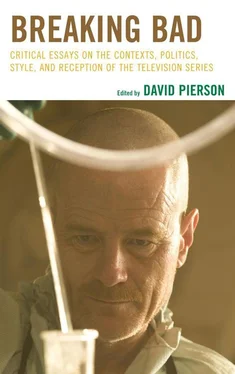The relationship between emotional and physical action is made evident in the initial episodes of the series, Breaking Bad , because the usual trajectory of developing characters through dialogue and interaction with other characters, which then builds to resolution through physical confrontation, becomes reversed. In the most familiar analysis of narrative structure, character development through the establishment of social and emotional stakes exists in order to ‘set-up’ some later climactic physical confrontation. In this configuration, physical acts are viewed as that which generates the resolution of the social and emotional stakes earlier placed in jeopardy.
In contrast, the first episodes in season one of Breaking Bad sustain a series of fast-paced, exciting events culminating in the talking sequence or “verbal communication” between Walter White (Bryan Cranston) and Krazy-8 (Max Arciniega) in the third episode, “…And the Bag’s in the River” (2/10/08). The normal narrative sequence is inverted so that physical action serves as establishing activity that leads to an emotional dramatic payoff.
Focusing only on the scenes that involve Walter, the pilot episode of season one (1/20/08) begins with a mysterious pair of pants falling from air to ground in slow motion, followed by shots of an RV driving frantically. In the front, sit a pantless Walter and an unconscious Jesse Pinkman (Aaron Paul), both wearing gas masks. In the back, we spot two male bodies on the floor—either unconscious or dead. They slide around uncontrollably in response to the frenetic movements of the RV. Presented as a series of quick cuts and rapid changes of camera angles, Walter then accidentally runs the RV off the road as, in the distance, we hear police sirens. Walter grabs a gun from one of the male bodies and exits the RV, where he videotapes a farewell message for his family. He then raises the gun, aiming it at what we assume are the oncoming police. We then cut to the events leading up to this moment beginning, as a title tells us, “Three Weeks Earlier.”
In swift succession, we see Walter turn fifty, teach a high school chemistry class, work a humiliating second job at a car wash for the sorely needed money, suddenly pass out and get taken to the hospital by ambulance, and learn he has inoperable lung cancer. Later, he goes for a ride-along with his DEA brother-in-law, Hank (Dean Norris), to the take down of a meth lab. Here he encounters his former student, Jesse, who has managed to escape the drug raid. Cornering Jesse later, Walter threatens to turn him into the DEA if Jesse refuses to partner with him in making and selling methamphetamine. Having no choice but to agree, Jesse purchases an RV in which to cook the meth, which the two do in the desert beyond Albuquerque.
Jesse takes the pure-grade crystal meth to Krazy-8 to sell. However, he is forced by Krazy-8 and Emilio (John Koyama) at gunpoint to lead them to the RV in the desert to show them where he obtained the drugs. In order to save his and Jesse’s lives, Walter agrees to show Krazy-8 and Emilio how to make the pure meth. Instead, he concocts a mixture that causes an explosion, rendering Krazy-8 and Emilio unconscious and presumably dead or dying, while he and Jesse escape by donning gas masks.
Walter frantically drives off with Krazy-8’s and Emilio’s bodies rolling around in the back of the RV. Walter’s pants, which he has taken off in order to preserve his ‘good’ clothes while he cooks, fly off the RV and into the air. We then return to the opening of the episode with Walter now turning the gun on himself, preparing to commit suicide before being apprehended by the approaching police whom, he believes, are coming for them. Instead, fire engines pass him by, hurrying to put out a fire started by their activities at the RV’s original location. Later that night, Walter returns home and has what we are led to believe is unusually passionate sex with his wife (Skyler: “Walt, is that you?”), at which point the pilot episode ends.
The second episode, “The Cat’s in the Bag…” (1/27/08), is more comedic in tone than the pilot, centering on sometimes gruesome, black humor as Walter and Jesse attempt to “clean up the mess” they have created in the pilot. But in both episodes much ground is covered through short scenes and a continually forward-moving series of events. “The Cat’s in the Bag…” chronicles a succession of mishaps as Walter and Jesse attempt to dispose of Emilio’s body and kill the badly wounded but still alive Krazy-8. Through the flip of a coin, Jesse is charged with dissolving Emilio’s body in acid while Walter becomes responsible for killing Krazy-8 whom, in the meantime, they have shackled to a column in Jesse’s basement with a rigid, motorcycle U-lock around his neck, rendering him immobile. Walter, however, cannot bring himself to murder Krazy-8. Instead, he provides the shackled Krazy-8 with water, a bologna and cheese sandwich, a waste bucket, toilet paper, and hand sanitizer, as if preparing him for a prolonged stay. Walter’s inability to act heightens the suspense as we wait for the inevitable encounter between him and Krazy-8.
The pace and tone of the third episode, “…And the Bag’s in the River,” vary from the initial two. It is slower and more contemplative, including a flashback to Walter’s past. Character development and character interaction play a more prominent role, and do so in an especially noteworthy manner between Walter and Krazy-8. The first time we see the two together in “… And the Bag’s in the River,” Krazy-8 insists that Walter look at him, complaining that the lock around his neck is degrading. Walter apologizes, indicating his susceptibility to feeling guilty for the inhumane way he is treating Krazy-8. Krazy-8 then exerts additional emotional pressure by challenging Walter to either kill him or let him go. Krazy-8 has sized Walter up, telling him that he isn’t suited for “this line of work”—the drug business. Again increasing the pressure and playing to Walter’s vulnerabilities, Krazy-8 emphasizes that Walter’s choices are either to let him go or to commit cold-blooded murder. In their initial to-and-fro, Krazy-8 extends a challenge to Walter, based on the guilt and fear the prisoner has accurately identified as his captor’s emotional ‘weaknesses.’
For his part, Walter has just learned that Krazy-8 knows who he is and where to find him if released. Walter attempts to make his decision on whether to commit cold-blooded murder through rational means, in a situation and over a choice that is wholly unreasonable within the terms of Walter’s existence heretofore. Nonetheless, he draws up a pro and con list over whether to kill Krazy-8 but finds that next to six ‘cons’ he can only come up with one ‘pro:’ “He’ll kill your entire family if you let him go.” [2] Walter’s reasons on the “Let Him Live” side of the page include: “It’s the moral thing to do”; “Won’t be able to live with yourself”; and “Murder is wrong!”
As the subsequent sequence between them makes clear, Walter must act by making a decision based on emotions—his ‘gut’ feelings—with which he is not particularly comfortable or adept at, rather than relying on his accustomed, ‘calm,’ ‘scientific,’ powers of reasoning. Thus begins an intricate emotional encounter between the two, in which they each attempt to gauge the other’s feelings and influence the other’s emotions over life and death stakes.
Walter again makes Krazy-8 a bologna and cheese sandwich, this time cutting off the bread crusts, having previously noticed that Krazy-8 does not like them. This seems an odd gesture of thoughtfulness in view of the situation facing the two men, but one that Walter strategically hopes will help ‘seduce’ Krazy-8 to engage with him. Walter places the sandwich on a yellow Fiestaware plate and heads down to the basement. Before he reaches Krazy-8, Walter suffers another coughing fit and passes out. [3] The fact that both Walter and Krazy-8 cough continuously serves as another link between them.
When he comes to, Krazy-8 informs him that he has been unconscious for ten to fifteen minutes. Then, in a startling admission given the context, in which Walter must decide whether to kill Krazy-8 or not while Krazy-8 knows full well this is the decision Walter must make, Walter confides in Krazy-8 that he has lung cancer. The two men share similarity of circumstances, both facing the threat of impending death that creates a certain bond between them. And, as we are beginning to understand, Walter is attempting to entice Krazy-8 to his side in order to escape having to kill him. Here, though, it is the captor who is trying to humanize himself to the prisoner.
Читать дальше












